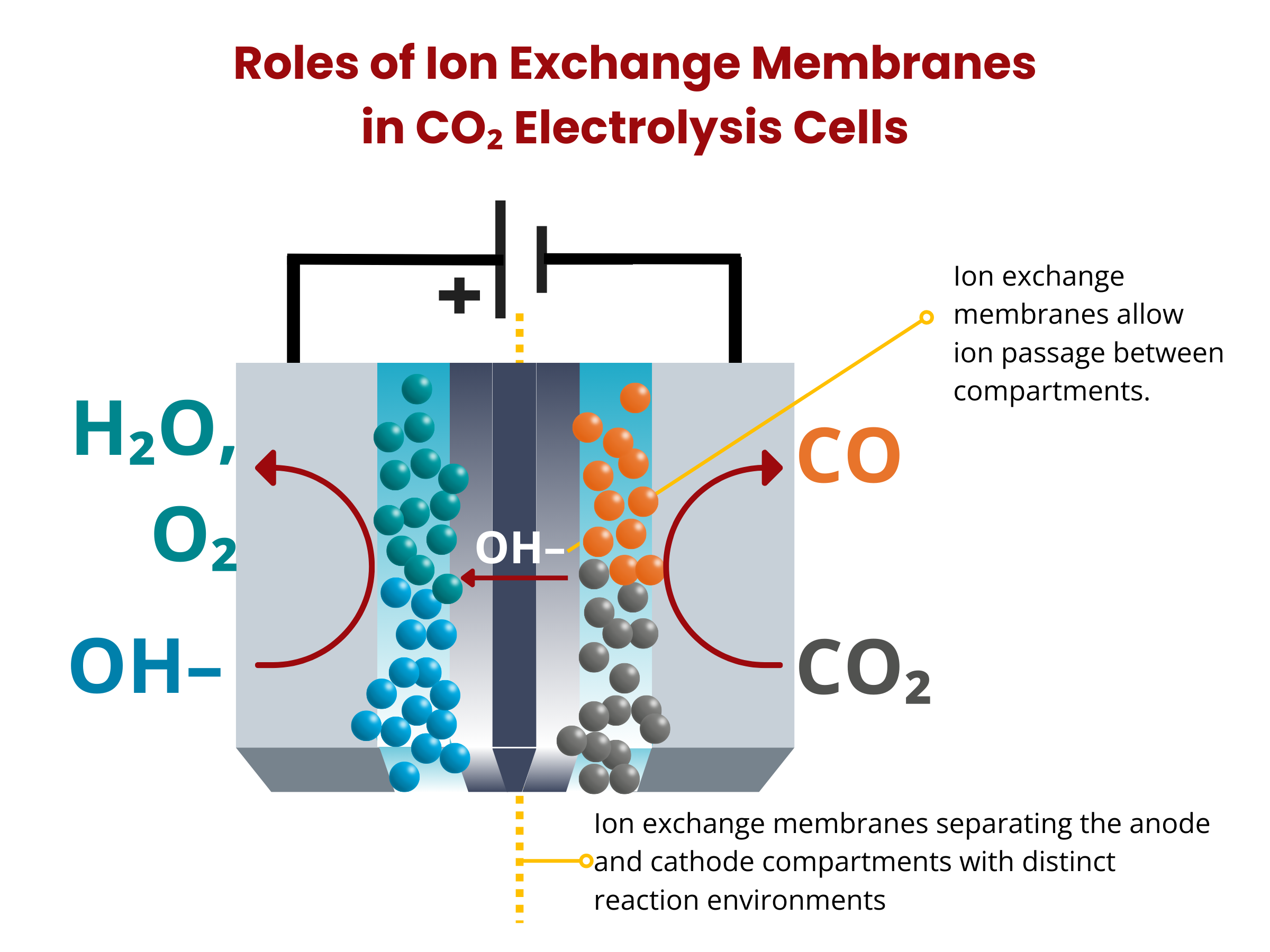
Carbon Capture and Utilization
Green Energy Integration
- Home
- Renewable Energy
- Carbon Dioxide Electrolyzers
- Ion Exchange Membrane for CO₂ Electrolysis
Ion Exchange Membrane for CO₂ Electrolysis
An ion exchange membrane is a thin barrier that allows the selective passage of specific ions from one compartment to another of devices, including but not limited to water electrolyzers and fuel cells. These materials are used in diverse industrial applications, making them instrumental in advancing technologies across several sectors.
Functions of ion exchange membranes for carbon dioxide electrolysis
Ion exchange membranes play a crucial role in carbon dioxide electrolyzers by separating the anode and cathode compartments with distinct reaction environments. This separation prevents the crossover of products and their reoxidation to CO2, effectively enhancing CO2 utilization and conversion efficiency. Additionally, these membranes facilitate the completion of the electrical circuit, ensuring electroneutrality by allowing ion passage between compartments. Similar to those used in fuel cells and water electrolyzers, ion exchange membranes are an important component of CO2RR electrochemical cells that affect the cell voltage and the overall energy efficiency of the device.

Property considerations for IEMs for carbon dioxide electrolysis
In carbon dioxide electrolysis cells, the choice of ion exchange membrane is crucial for efficient performance. The thickness of the membrane is a key factor. Thicker membranes can reduce the extent of crossover and reoxidation of the reaction products but also increase ionic resistance at the same time. Achieving a balance is essential to ensure that the membrane maintains sufficient ionic conductivity while being thick enough to impede crossover, especially under high current densities. At high current densities, the membrane must effectively transport ions generated from the carbon dioxide reduction reaction (CO2RR) to prevent system overload. Inadequate conductivity could impede the conversion of CO2 to valuable products. Thus, optimizing membrane design involves considering thickness, ionic resistance, and conductivity to achieve high selectivity and efficiency in CO2 electrolysis. Learn more about the key properties of ion exchange membranes here.
Anion exchange membranes for carbon dioxide electrolysis
Anion exchange membranes (AEMs) stand out as the most common choice for carbon dioxide electrolysis cells. The fixed positively charged groups in AEMs bring alkalinity to the device, offering several advantages. Firstly, alkaline systems can utilize non-platinum group or non-noble metal catalysts, which are cost-effective and abundant, because of the reduced corrosivity compared to acidic systems. Secondly, proton exchange membranes allow the flow of H+ ions to the cathode, which lowers the pH in the cathode compartment. Low pH tends to favor the kinetics of parasitic reactions, such as hydrogen evolution, which competes with CO2RR, lowers CO2 utilization, and increases the cell voltage.
Comparison between IEMs for carbon dioxide electrolysis
| Property | Proton Exchange Membranes (PEMs) | Anion Exchange Membranes (AEMs) |
|---|---|---|
| Charge Carrier | H+ ions | Anions |
| Operating pH | Low (acidic environment) | High (alkaline) |
| Catalyst Compatibility | Requires noble metal catalysts (e.g., platinum group metals) | Allows the use of cheaper non-noble metal catalysts |
| Corrosiveness | More corrosive environment due to low pH | Reduced corrosivity compared to acidic PEM systems |
| CO2 Utilization | Lower because parasitic reactions (e.g., hydrogen evolution) is favored at low pH | Enhanced due to reduced parasitic reactions |
| Cell Voltage | May experience higher cell voltage | Generally lower cell voltage with reduced parasitic reactions |
AEMIONTM anion exchange membranes for carbon dioxide electrolysis
AEMION+™ membranes are a cutting-edge anion exchange solution known for its high performance and excellent stability. Although they are well suited for alkaline operating conditions, Aemion+™ membranes also shows exceptional stability in low pH (acidic) conditions, ensuring an extended product life cycle.
AEMION+™ AF3-CLF9-25 and AEMION+™ AF3-CLF9-50 are anion exchange membranes specifically developed for CO2 electrolysis. Both AEMs are reinforced with polytetrafluoethylene that improves the water management capabilities of the membrane, ensuring that the AEMs have excellent conductivity, permselectivity, and stability with low risks of swelling during operation.
Trust AEMION+™ for reliable and efficient CO2 electrolysis. Have questions or need more info? Contact us about your ion exchange membrane needs.
| Product | Type | Thickness (um) | Tensile strength (MPa) | Young's Modulus (MPa) | Elongation (%) | Water uptake (%) | Max process temp (°C) | Reinforced |
|---|---|---|---|---|---|---|---|---|
| AF3- CLF9-25 | Anion | 25 | >85 | >480 | >80 | <15 | 150 | Nonwoven PTFE |
| AF3- CLF9-50 | Anion | 50 | >80 | >450 | 80–120 | <15 | 150 | Nonwoven PTFE |

